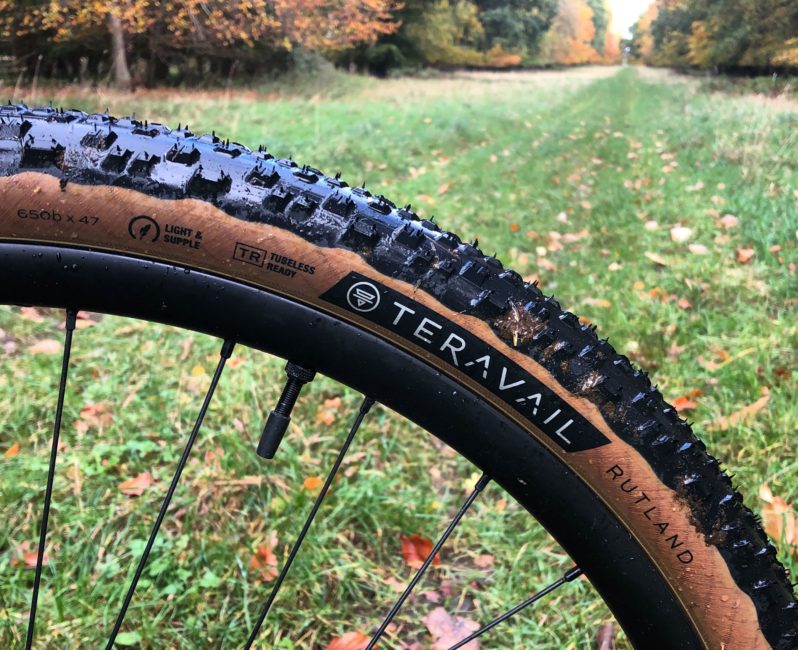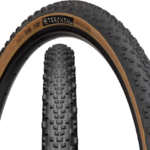As gravel bikes evolve into ever more capable off-roaders, demand for gnarlier tyres is growing. The Teravail Rutland is a gravel tyre that has been designed to fill this gap by offering grip in loose and muddy conditions. The Rutland’s tread pattern features large ramped, tightly spaced centre lugs to reduce rolling resistance and more aggressive knobs on the shoulders to provide grip in the loose. It’s somewhere between a WTB Resolute and a WTB Sendero in terms of knobblyness.
On test here is the premium ‘Light & Supple’ compound which as the name suggests, is a lighter alternative to Teravail’s ‘Durable’ compound. This tubeless-ready casing keeps the weight down by scrimping out on puncture protection belts. Not that we found any issues with punctures on the Rutland or for that matter, the Teravail Cannonball which we tested earlier in the year. Omitting the protection belt also makes the tyre feel a lot more pliable than its 60tpi casing would suggest. Should your riding take you to some seriously rocky places, the extra protection offered by the ‘Durable’ casing would be a sensible move. If you are not a 650b fan or your bike can’t fit them, the Teravail Rutland also comes in 700c in 38 and 42 mm widths.
Set up
There is little to report as far as fitting the Teravail Rutland gravel tyres goes. There was no wrestling with the beads while mounting to the Light Bicycle 650b carbon rims, and they inflated with a regular track pump. The Rutland tyres have held pressure well, not losing more than a couple of psi over several weeks.
On the ride
Designed for the rougher end of the gravel spectrum, but the Teravail Rutland tyre is also extremely capable in mud. In the last few months, the Rutland has been a saviour for my riding. Usually once it gets muddy, I’m either confined to roads, or dusting off the mountain bike. The Rutland finds surprising levels of bite in slippery trails and can hook up in the corners… If you have the confidence to make them dance! Get them muddy and they’ll shed the load quickly rather than morph into chocolate-coated hula hoops.
Hitting the inevitable tarmac to link up the trails wasn’t the drag fest I was expecting, as those ramped centre knobs exhibit little rolling resistance. There is some tell-tale thrum of knobbly tread on tarmac, but the Rutland rolls far better than many similar aggressive gravel tyres.
The Light & Supple casing lives up to its name and feels great when run at low pressures. 32 – 38psi was my operating range during the test, depending on the terrain I was riding. Riding with low pressures in flinty conditions is a risky pastime but the Rutland tyres survived unscathed and without any punctures.

A pricey contender
Everyone loves to moan about the price of tyres and unfortunately, the Teravail Rutland will make a few eyes water on that front. The Light & Supple version retails at £50, while the extra puncture protection adds £5 extra. The closest performing tyre to the Rutland is WTB’s Sendero at £45. Is it worth the extra? It’s easily the best aggressive gravel tyre we’ve had on test at ADVNTR.
As with all of Teravail’s tyres, the Rutland is available in both traditional black sidewall and in tan. There is no premium for the current trendsetters choice of sidewall colour. Get the best value for money from your purchase and go tan: they weigh 70g less than the black variant at 465g.
The Teravail Rutland verdict
For those looking for a quasi-MTB singletrack ripper, the Teravail Rutland ticks that box. It also performs exceptionally well in muddy conditions and gives riders a higher volume alternative to CX tyres.
Last modified: 14th December 2020















What rims were they as I am looking into this setup? Were they hookless? And what was the tyre width on these rims?
I recently bought these partly on the reccomendation of this and other good reviews. So far – about 3 weeks and 10 odd mixed gravel/road rides in I am moderately happy with them.
Good things are the light weight, cushy ride at lower pressures and decent grip, 650b took a little getting used to – they spin up very quickly and accelerate super fast but bobble about a bit more/don’t roll quite as well over the rougher trails than 700c even with the larger 47mm tyre volume (not the tyre’s fault just the wheel size). I still really like 650b so far, its makes for a fun and responsive ride.
Bad things are that they don’t seem to be very durable. The sidewalls are a particularly weak area and with only 60tpi they may not last as long as I’d hoped judging by performance so far. There is already spots where sealant is leaking through at multiple points on the sidewalls and I’ve already had to remove the rear tyre and use some gorilla tape to seal a hole at the sidewall right down near the rim bead. At £50 a pop I’d say this is pretty subsandard. I’m 70kg and would say I’m a fairly adept bike handler with a good number of years of mountain biking experience of dodging sharp rocks and drainage channels so was a little disappointed in this.
Perhaps I’m asking too much of a modern gravel tyre?? – if I was to buy again I’d either fork out the extra for the durable version and forgo the nice tan sidewalls, or buy slightly heavier tyres with thicker sidewalls.
What kind of pressures are you running Charlie? With a puncture near the bead sounds like you might need to up the pressure? But agreed, after 3 weeks I wouldn’t expect to be experiencing sealant through the sidewalls. Perhaps best to get in touch with where you bought them.
Thanks Catherine. Good advice- think I was running them about 30psi when I got the puncture but was descending a grav trail with dirt covered drainage pipes and may have bottomed out once or twice. Will be running high 30s from now on
Hi there , I reckon you should get sone cushcore inserts and keep those pressures low (22psi)
it’ll give you immense grip and absorb all the hits plus protect the tyre.
how about real wordl size on those 650 X 47s? I just installed them on my brand new GRC1400 wheels that have 24mm inside, and they are about 44-44,5mm wide.
I read about these 650B tyres (here) and went on searching the web for further info. Did buy a set… and when mounted they seemed a little small at first. But – as it goes all the time apparently – they needed to “set”. After two days and some mileage on them they measured 47mm on my DT Swiss GRC1400s (full 24mm inner rim width). On the diameter however, the claim often made that a 650B X 47 equals a 700c X 30 mm is (as expected) wrong.
I have a set of Zipp 303s with 33mm Gravelkings for gravel (700c obviously), and they are just bigger. Not by much, but enough to make a difference. Smaller diameter helps on climbs and in the rough… but my BB sits lower too with those 650B wheels.
As for ride quality on MTB territory: great! My girlfriend rode her Cube Reaction with the 2.25″ racing Schwalbe set and often she had more stable control but I managed through the technical parts by experience, and what James refers to in the article as “dancing”. On the singletracks though… I ripped; Wasn’t even going all out (because of the Easter ride with my partner) and I got an all time top 10 in Strava first time out. No explanation needed I guess. So, resuming: 650B makes sense on a non suspension gravelbike to be optimal from heavy gravel to XC rides. On singletrack and somewhat rougher parts they will give you wings, but in the technical parts it will ask a bit more concentration and skill. Then again… if you set the same total time, who cares: the thrill of conquering a technical course on a non suspension bike with dropbars and flying singletracks and woodpaths, isn’t that the fun MTB is all about?